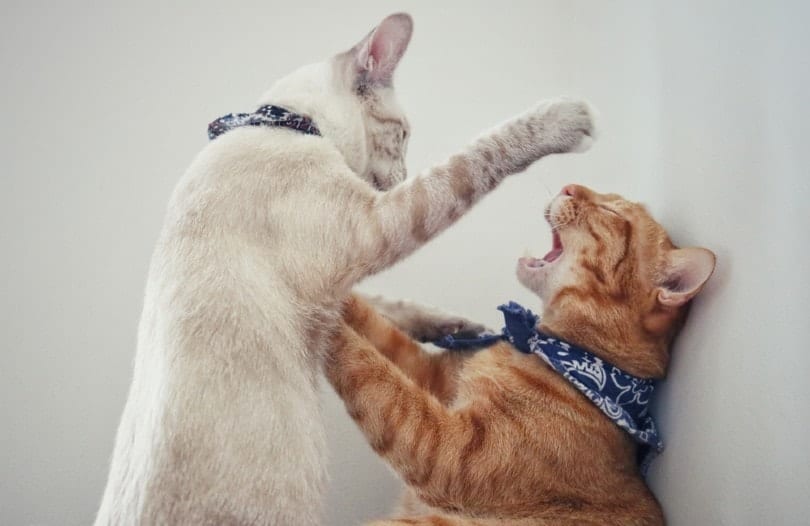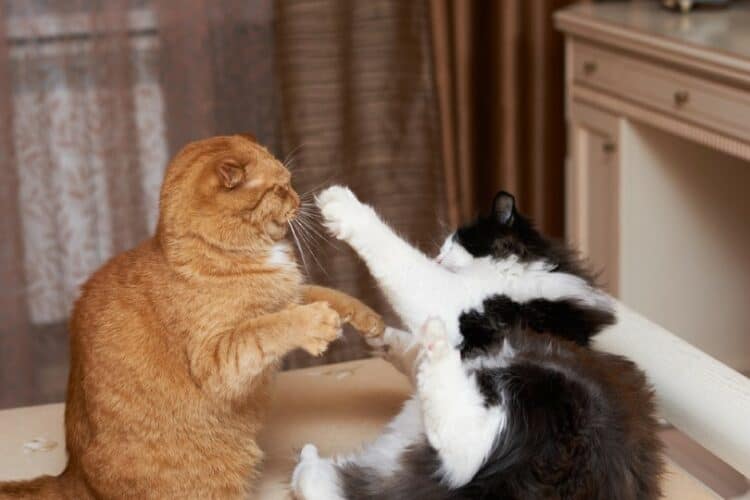Cats have natural hunting instincts that they stimulate by engaging in activity, and mock fighting is one of them. Although watching your cats play rough can be adorable, it can be hard to tell if they are actually fighting or just playing. Learning to recognize the difference is an important part of being a cat owner.
While play fighting is normal behavior for cats, the playing can escalate and turn into a fight. They can sometimes get carried away, or their relationship dynamic may change. To help you distinguish what your cats are up to, we have put together these five signs, so you know when it’s time to intervene.
The 5 Signs to See if Cats Are Playing or Fighting
1. Observe Their Body Language
A cat’s ears are usually upright and relaxed, and if they are pointing back and pinned down, it could mean they are tense and is a clear sign they could be fighting. Extended claws and upright fur are another sign that your cats are on the defensive, and their body position can be a tell-tale sign that they are fighting. If they are leaning onto their back paws, their tail is upright and stiff, and their eyes are dilated, then it may be time to intervene. If they are in a normal, relaxed position, then it is likely they are just having a good time.
2. Vocalization
Vocalization is also a means for cats to communicate their feelings. If the pouncing and rolling around don’t include any vocal sounds, your cats are most likely mock fighting or playing. If there is hissing or screaming, the cats are fighting. The guttural sounds that come from an angry or scared cat are obvious and very intimidating.
3. Are They Taking Turns
When cats are mock fighting, they will usually take turns being on top and being in the lead. They will occasionally separate and start again, but you don’t need to be concerned if they are sharing the lead role. Sometimes one cat prefers to be the top cat, so to speak, and this dynamic can work as long as they are in agreement and the other cat is willing to engage.
4. Speed
Playful cats will usually fight in a calm and steady manner. When they are play fighting, they will stop and start to take a break and change positions. If cats are fighting, things can get fast and frantic, and they won’t stop until one of them wins. If there is chasing involved and they are taking turns, it is probably not serious, but if one cat is doing the chasing, then the playtime is becoming serious.
5. Are They Strangers or Roommates?
If two cats that are wrestling do not know each other, it is more than likely they are fighting because cats that are strangers will not play together. When a new cat comes onto the scene, it is usually a threat to the cat that already lives there, and their fight or flight instincts will kick in. If there is nowhere to run, they will end up fighting.

Why Do Cats Fight?
Cats are territorial and will fight to defend their territory. New or strange cats are usually received as intruders, and their fussy nature may accept one cat and not another.
Hormones also play a part in aggression between cats. When male cats reach their social maturity, inter-cat aggression can become a behavioral problem, usually because they are competing for mates. Jealousy can also be a reason for a cat to pick a fight. A new cat in the home can be seen as a rival, causing the existing pet to compete for attention.
Why Do Cats Play Fight?
Play fighting is an instinctual need for cats. They will often engage in mock aggression to meet their primal needs for hunting and guarding their territory, which are necessary for the survival of a wild cat.
How To Break Up a Cat Fight
You can help break up a cat fight by making a loud noise. Shouting or making noise by banging something together will distract the cats and hopefully break up the fight. Placing a barrier between them to block their view of each other can help end the fight. A squirt of water will separate cats in seconds, but never hit your cats or try to grab them with your hands as you will most likely get scratched or bitten.
Keep your cats separated after a fight to calm them down and gently reintroduce them after a while.
How To Help Cats Get Along
Introducing a new cat should be done slowly by giving the new cat its own safe room. For the first week, the only interaction the cats should have is trying to paw each other through the door. Give each cat a towel to sleep on during the first week, and then switch their towels to familiarize them with each other’s scents. Slowly introduce them until they have gotten used to each other.
To avoid fights, ensure your cats have their own space and are given individual attention. They should have their own bowl, litter tray, toys, and bed. Supervise their interactions and intervene before a fight develops. Cats that are not spayed or neutered are more prone to aggression, and you should consider getting them fixed to avoid conflicts.
Some cats may never get along, but they can learn to accept each other with a little time and patience.
Conclusion
If you own more than one cat, mock fighting will be a regular occurrence in your home. It is critical to differentiate the behaviors of aggressive fighting and playing to ensure your cats are getting along. Understanding your cat’s territorial behavior will help you introduce a new kitty, and a positive introduction will help them get along and accept each other. Not all cats will be best mates, but they can learn to live harmoniously.
Feature Image Credit: Shutterstock
















